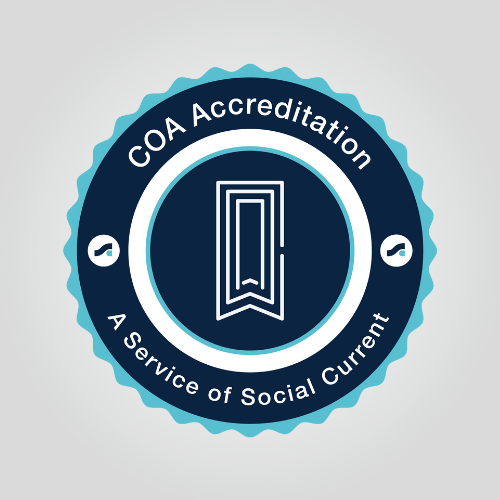COA Accreditation
Creating Effective Workgroups on the Road to Accreditation
When beginning the accreditation process – specifically the completion of the Self-Study – one of the most intimidating challenges can be trying to figure out how to organize the work and delegate it to your staff. You don’t need a certificate in project management to accomplish this task (although having one won’t hurt!). What you do need is prep time, focus, and a solid understanding of what’s expected.
This post will discuss how to form effective workgroups that can assist your organization with completing the necessary work in order to achieve accreditation – and hopefully improve your organization’s operations as well. Now let’s get started.
When talking with organizations in COA’s network, we see a variety of types of workgroups. Some small organizations do not form new workgroups; they simply utilize a currently existing structure to fill the role. On the other hand, large organizations may develop multiple workgroups that focus on different aspects of the Self-Study. Only the organization can determine what the best model is going to be, but we can certainly explore some basic characteristics.
According to Kozlowski, S. W. J., & Bell, B. S. (2013), workgroups have the following qualities:
- They consist of two or more people
- Their participants are part of the same organization
- They have a common goal
- Their tasks are completed together and individually
- They involve social interaction
- They retain boundaries established by the organization
- They are part of the culture of the organization
One is the loneliest number
If your workgroup only consists of you thenyou should probably revisit your plan to achieve accreditation. Even for small organizations, all levels of staff should be involved in some way. There are multiple benefits to involving many people. First off, staff will have a better understanding of the importance of accreditation if they are embedded in the process. If the process is presented to them in a positive way then they can take ownership. A common question is “how can you present accreditation to staff in a positive way?” While it’s difficult to imagine how anyone can view accreditation in a negative light, talk with your staff – particularly those that you want to engage in workgroups – and bring the focus to achieving client outcomes. The purpose of accreditation is to improve outcomes for those that receive your services. Every action that takes place in accreditation should be tied to the end user: the consumer.
Another way that staff can buy-in to participating in a workgroup is to view it as a professional development opportunity. In fact, you would be remiss if you didn’t. Think about your shining case managers, clinicians, administrative assistants, residential managers, and foster care workers who have impeccable paperwork, organized with to-do lists, and always volunteer for new projects. Working on COA-related activities can improve their administrative and leadership skills, expand their knowledge of social service management, and program development.
“Every action that takes place in accreditation should be tied to the end user: the consumer.”
A chance for collaboration!
Another commonality in workgroups is that they are all part of the same organization. Note that it’s within the organization, but not necessarily within the same department, division, or satellite office. Workgroups foster cross-departmental collaboration. For example, let’s say that you are going to create a workgroup that focuses solely on drafting and reviewing procedures for the organization. For medium-large organizations, having this type of committee helps ensure that there is consistency across the organization, standards are still being met, and duplications are avoided. Including staff from different departments and different levels can provide different perspectives. Perhaps a member of management reviews a procedure and thinks “wow, this is great and will really help improve the reliability of our data.” Then a member of the direct service staff, who is also part of this committee, reviews the same procedure. She may have a comment such as “the intent of this procedure is spot-on, but the ability to put this in practice is unrealistic.” What’s better than a well written procedure? – A procedure that is actually practical. Having a diverse group of individuals within your organization as part of the accreditation workgroup is essential to change that is effective.
Find common ground
Common goals are an essential characteristic of workgroups. Having common goals relates to proper planning. If you establishing one committee or 3 committees to complete the work, there needs to be a goal that is achievable. You may think, “The goal is to get accredited.” Good point, that is the goal, but that’s the goal of the entire organization; not of the workgroup. The workgroup’s goal may be to establish a working PQI system, assess current practices to COA standards, or assemble the Self-Study. The goal of each workgroup will clearly delineate its role in completing the larger mission: achieving accreditation – and as we discussed earlier - to improve outcomes for consumers.
To further break down the goal, we need to identify specific tasks that support the actual completion of the workgroup’s goal. Planning, again, comes into play. Recognizing that planning is not everyone’s strong suit, there are some resources out there to assist. While COA doesn’t endorse any specific resource, we do find these helpful. Meister Task is an efficient task management application that can be used to organize individual tasks as well as collaborative tasks. Consistent with our definition of workgroups, there are both individual tasks and tasks that people must work on together. This web application can help support and provide structure to both. Another great application is Wunderlist. It provides some of the same functionality with a different style. If you are not quite ready for that level of organization and need some foundational support, try reading Getting Things Done: The Art of Stress-Free Productivity by David Allen. It’s an easy read that will help you organize your life, as well as your accreditation work. Remember, if you do utilize any of these resources, it’s recommended to take a full day to sit back and focus on implementing these systems for your work.
Assigning the work
However you handle the workload, a workgroup has tasks that are completed individually and some that are completed by more than one person or a subgroup of the committee. When tasks of the workgroup are being assigned to its members you will want to consider the strengths and weaknesses of each member. Initially, it may be your gut reaction to assign tasks that are good matches to individuals’ strengths; however, also consider matching someone’s weakness to a task to help them further develop. Perhaps pairing that person with someone who does have more experience can be a great learning opportunity. Make the most out of your accreditation experience and use it to support a positive learning environment. Maybe you can even develop mentorships within your staff, with the accreditation work as the central theme.
Involve social interaction, have you ever tried to hold a committee without social interaction? Typically that’s an email with directives to everyone involved with no discussion. Sometimes effective; most of the time not. At the beginning of the process of forming your workgroups, you will be concurrently developing the buy-in of the workgroup members. Meeting in-person, with sugary treats, that typically helps (personal favorite: Insomnia Cookies). If you can’t have fresh cookies delivered, consider holding the meeting outside of your organization, at least for the first time. Use this common goal, develop strong collegial bonds that last past COA Accreditation. And finally, manage your meeting efficiently. Here are some tips from Mindtools.com.
Introducing accreditation to your culture
Maintaining boundaries that are consistent within the organization may be a little bit more challenging for an accreditation workgroup. The group may be perceived by others in the organization as closed-off or working on something has nothing to do with the rest of the staff. One remedy for this perception is to provide communication about the status of the workgroup throughout the process to the rest of the organization. The workgroup is not charged with setting completely new and rigid policy, determining who at the organization is underperforming, or planning a coup d’état. Transparency is key, solicit feedback from staff who may not be directly involved. Always ask for volunteers, although don’t expect a waitlist. The accreditation workgroup is not a clique; it is a model for how people work as a team to achieve a seemingly insurmountable task.
Lastly, it is important to maintain key components of the organization’s culture. You can expect shifts, bumps and slides during the process, but the core of your organization will grow stronger. Your culture is the cornerstone of stability for your staff, who spend 40 hours of their lives there each week. It is a safe place for consumers whose lives you change. It is part of the connective tissue that holds your community together. Change may be inevitable but the culture of your organization is the reason for your continued success.
Share your tips!
What tips do you have for developing a strong workgroup or sustaining it once it is in place? Please leave a comment below and help others learn from your experiences.



